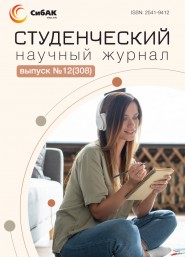Статья опубликована в рамках: Научного журнала «Студенческий» № 12(308)
Рубрика журнала: Педагогика
Скачать книгу(-и): скачать журнал часть 1, скачать журнал часть 2, скачать журнал часть 3, скачать журнал часть 4, скачать журнал часть 5, скачать журнал часть 6, скачать журнал часть 7
DEVELOPING CRITICAL THINKING IN YOUNGER SCHOOLCHILDREN IN THE LESSONS OF THE OUTSIDE WORLD: PRACTICAL APPROACHES AND EFFECTIVE TECHNIQUES
РАЗВИТИЕ КРИТИЧЕСКОГО МЫШЛЕНИЯ У МЛАДШИХ ШКОЛЬНИКОВ НА УРОКАХ ОКРУЖАЮЩЕГО МИРА: ПРАКТИЧЕСКИЕ ПОДХОДЫ И ЭФФЕКТИВНЫЕ ПРИЕМЫ
Кенжаева Севара Шухратовна
студент, Белгородский государственный национальный исследовательский университет,
РФ, г. Белгород
Богачев Роман Евгеньевич
научный руководитель, канд. филол. наук, доц., Белгородский государственный национальный исследовательский университет,
РФ, г. Белгород
ABSTRACT
The article deals with topical issues of the development of critical thinking among younger schoolchildren in the lessons of the surrounding world. The necessity of developing this skill in primary school for successful adaptation to the modern information society is substantiated. Practical approaches and effective techniques aimed at developing the ability to analyze, evaluate and interpret information, as well as formulate their own reasoned conclusions are presented. Special attention is paid to interactive teaching methods that promote the active involvement of students in the educational process.
АННОТАЦИЯ
В статье рассматриваются актуальные вопросы развития критического мышления у младших школьников на уроках окружающего мира. Обосновывается необходимость формирования данного навыка в начальной школе для успешной адаптации к современному информационному обществу. Представлены практические подходы и эффективные приемы, направленные на развитие умения анализировать, оценивать и интерпретировать информацию, а также формулировать собственные аргументированные выводы. Особое внимание уделяется интерактивным методам обучения, способствующим активному вовлечению учащихся в образовательный процесс.
Keywords: critical thinking, primary school students, the world around them, elementary school, educational process, interactive methods, analysis, assessment, interpretation, argumentation.
Ключевые слова: критическое мышление, младшие школьники, окружающий мир, начальная школа, образовательный процесс, интерактивные методы, анализ, оценка, интерпретация, аргументация.
In the modern world, characterized by the rapid development of science and technology, the increased volume of information and its accessibility, critical thinking is becoming particularly important. The ability to analyze, evaluate and interpret information, formulate your own reasoned conclusions becomes a necessary tool for successful adaptation to changing conditions and making informed decisions. The formation of critical thinking should begin already in elementary school, creating the foundation for the further development of this skill at subsequent stages of education.
The lessons of the surrounding world provide ample opportunities for the development of critical thinking among younger students. We suggest considering several practical approaches and effective techniques that can be used in the classroom.
Information analysis tasks:
Comparing objects and phenomena: Ask students to compare different objects and phenomena of the surrounding world (for example, trees of different breeds, seasons, natural areas), highlighting similarities and differences, establishing patterns.
Finding errors in information: Encourage students to find errors in texts, diagrams, and drawings related to the topic of the lesson.
Tasks for evaluating information:
Determining the reliability of information: Ask students to evaluate the reliability of information obtained from different sources (for example, a textbook, an encyclopedia, an Internet site), compare information from different sources, and identify contradictions.
Assessment of the consequences of actions: Invite students to predict the consequences of certain human actions in nature, to assess their positive and negative impact on the environment.
Information interpretation tasks:
Reading diagrams and diagrams: Invite students to read diagrams and diagrams depicting various processes and phenomena in the world around them, and draw conclusions based on the information provided.
Explanation of cause-and-effect relationships: Invite students to explain the causes of certain phenomena in the world around them, to establish cause-and-effect relationships between them.
Using the practical approaches and effective techniques presented in this article will help elementary school teachers successfully develop critical thinking in their students in the lessons of the outside world.
References:
- Amosov, N.M. Modeling of thinking and psyche / Amosov, N.M.yu.M.: Naukova dumka, 2019. - 303 p.


Оставить комментарий